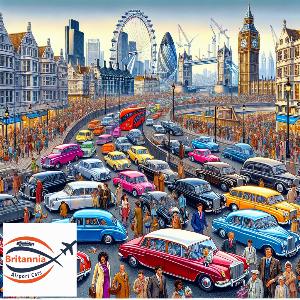Architectural Wonders – A Tour of London’s Modern and Historic Buildings

The Shard
The Shard, an architectural marvel in London, stands as a testament to the city's blend of historic and modern design. Towering at 1,016 feet, it's the tallest building in Western Europe, offering panoramic views of the city. Designed by renowned architect Renzo Piano, The Shard's 72 habitable floors house offices, restaurants, a hotel, and viewing galleries. Its unique, glass-clad pyramidal design is inspired by the railway lines next to it, and it's named for its resemblance to a shard of glass. The Shard is not just a building; it's a vertical city, a living, dynamic part of London's skyline. Its innovative design and construction have made it a symbol of 21st-century London, seamlessly integrating with the city's historic architecture. The Shard is a must-visit for architecture enthusiasts and anyone interested in the evolution of urban landscapes.
Tower of London
The Tower of London, a UNESCO World Heritage Site, is a compelling blend of architectural styles that have evolved over a millennium. This historic castle, located on the north bank of the River Thames, was founded towards the end of 1066 as part of the Norman Conquest. Its White Tower, which gives the entire complex its name, is a perfect example of Norman military architecture. Over the centuries, the Tower has served various purposes, including a royal palace, prison, treasury, and even a menagerie. Today, it houses the Crown Jewels of England, attracting millions of tourists annually. The Tower's architecture, with its imposing stone walls and turrets, is a testament to the changing styles and functions of buildings throughout history. Its survival amidst the modern cityscape of London makes it a must-visit architectural wonder, offering a fascinating glimpse into the city's rich past.
St. Paul's Cathedral
St. Paul's Cathedral, an iconic symbol of London, is a masterpiece of English Baroque architecture. Designed by Sir Christopher Wren after the Great Fire of London in 1666, it was completed in 1710 and has since dominated the city's skyline with its majestic dome. The cathedral's exterior is a marvel, but its interior is equally impressive, featuring intricate mosaics, stone carvings, and the Whispering Gallery, known for its unique acoustics. The cathedral has been the site of many significant events, including the funerals of Lord Nelson and Winston Churchill, and the wedding of Prince Charles and Lady Diana. Climbing to the top of the dome offers panoramic views of London, making it a must-visit for architecture enthusiasts and history buffs alike. St. Paul's Cathedral is not just a building; it's a testament to London's resilience and enduring spirit.
The Gherkin
The Gherkin, officially known as 30 St Mary Axe, is a marvel of modern architecture in the heart of London's financial district. This iconic structure, completed in 2003, stands at 180 meters tall, boasting 41 floors of commercial space. Its unique, pickle-like shape, designed by renowned architect Norman Foster, is not just aesthetically pleasing but also environmentally efficient, reducing the building's reliance on air conditioning. The Gherkin's spiraling strips of glass allow natural light to flood in, offering panoramic views of the city. Its distinctive design has made it a standout in London's skyline, symbolizing the city's blend of historic tradition and innovative spirit. The Gherkin is more than just a building; it's a testament to London's architectural prowess and a must-visit for any architecture enthusiast.
Westminster Abbey
Westminster Abbey, a true architectural wonder, stands as a testament to London's rich history and architectural prowess. This Gothic masterpiece, dating back to the 10th century, is a blend of both modern and historic design elements. Its intricate stonework, soaring arches, and stunning stained glass windows are a sight to behold. The Abbey has been the coronation church since 1066 and is the final resting place of seventeen monarchs. The present church, begun by Henry III in 1245, is one of the most important Gothic buildings in the country. The interior is a veritable museum of English history. Among other things, it houses Poets' Corner, the Chapter House and Pyx Chamber. The Abbey's most recent architectural addition, the 21st-century Gothic tower, houses the Queen's Diamond Jubilee Galleries. A visit to Westminster Abbey is not just a journey through architectural grandeur, but also a deep dive into the annals of British history.
The British Museum
The British Museum, located in the heart of London, is a testament to architectural grandeur and historical significance. This iconic structure, designed by Sir Robert Smirke in 1823, is a blend of Greek Revival and modern architecture. The museum's façade, adorned with 44 columns, is reminiscent of the ancient Greek temples. The most striking feature, however, is the Great Court, a two-acre space enclosed by a stunning glass roof, designed by Foster and Partners. This architectural marvel is the largest covered public square in Europe. Inside, the museum houses a vast collection of world art and artefacts, offering a journey through over two million years of history. The British Museum is not just a treasure trove of historical artefacts, but also a masterpiece of architectural design, making it a must-visit on any architectural tour of London.
Buckingham Palace
Buckingham Palace, an iconic symbol of the British monarchy, is a must-visit architectural wonder on any tour of London's historic buildings. Constructed in 1703, the palace has undergone numerous renovations, transforming it into the grand structure we see today. The palace's façade, a masterpiece of neoclassical design, is a testament to architect John Nash's vision. The 775-room palace, including 19 staterooms, 52 royal and guest bedrooms, and 78 bathrooms, is a marvel of architectural grandeur. The palace's most famous feature, the balcony, has been the site of countless royal appearances. The Changing of the Guard, a traditional ceremony that takes place in the palace's forecourt, is a spectacle that draws tourists from around the world. The palace's lush gardens, the largest private gardens in London, are a testament to landscape design. Buckingham Palace, with its rich history and architectural splendor, is a testament to London's enduring allure.
Tate Modern
Tate Modern, a beacon of contemporary art, is one of London's architectural marvels. Housed in the former Bankside Power Station, it was transformed into a museum by architects Herzog & de Meuron in 2000. The building's industrial past is evident in its design, with the towering chimney and vast Turbine Hall creating a dramatic backdrop for the art installations. The Switch House extension, added in 2016, is a striking contrast with its twisted, pyramid-like structure. Made from perforated brickwork, it allows light to filter into the interior, creating a unique viewing experience. The Tate Modern not only showcases world-class art but also offers panoramic views of London from its 10th-floor viewing platform. This architectural wonder is a testament to the successful blending of old and new, making it a must-visit on any architectural tour of London.
The London Eye
The London Eye, an iconic feature of London's skyline, is a must-visit for any architectural enthusiast. This modern marvel, standing at a staggering 443 feet, is the world's tallest cantilevered observation wheel, offering breathtaking panoramic views of the city. Designed by architects David Marks and Julia Barfield, the London Eye was opened to the public in 2000 and has since become a symbol of modern London. Its 32 high-tech glass capsules, representing the city's 32 boroughs, rotate at a leisurely pace, allowing visitors to soak in the stunning vistas of the city's historic and contemporary architecture. The London Eye's innovative design and engineering have made it a standout in a city known for its architectural grandeur. It's a testament to London's ability to blend the old with the new, making it a must-see on any architectural tour of the city.
Houses of Parliament
The Houses of Parliament, officially known as the Palace of Westminster, is an architectural marvel that stands as a symbol of London's rich history. This iconic structure, nestled on the banks of the River Thames, is a stunning blend of Gothic and Perpendicular Gothic styles, designed by architects Charles Barry and Augustus Pugin in the mid-19th century. The building's most recognizable feature, the Big Ben, is a towering clock tower that punctuates the London skyline. Inside, the Houses of Parliament are a labyrinth of ornate halls, chambers, and corridors, each filled with intricate details and historical significance. The building is not just a monument to the past, but a working body where the UK's political decisions are made. Whether viewed from a river cruise or explored on a guided tour, the Houses of Parliament are a testament to London's architectural prowess and a must-visit for any architecture enthusiast.
Our Latest Blog Posts

Family Bonding: Fun Activities for All Ages in London
Blog about Family Bonding: Fun Activities for All Ages in London
Read More
Springtime in London: Cherry Blossoms and Blooming Gardens
Blog about Springtime in London: Cherry Blossoms and Blooming Gardens
Read More
Regents Canal Cruise: A Serene Journey Through Londons Heart
Blog about Regents Canal Cruise: A Serene Journey Through Londons Heart
Read More
Budget-Friendly London: Explore the City Without Overspending
Explore London on a budget! Discover top attractions, dining, and travel tips for an affordable yet unforgettable experience in the city.
Read More
Fitness Fanatics: Running and Cycling Routes in London
Blog about Fitness Fanatics: Running and Cycling Routes in London
Read More
Urban Nature: Wildlife Encounters in Londons Parks
Blog about Urban Nature: Wildlife Encounters in Londons Parks
Read More
Understanding London Airport Minicabs: Making Your Journey Easier
Blog about Understanding London Airport Transfers: Making Your Journey Easier
Read More
Secret Gardens: Hidden Green Oases in the Heart of London
Blog about Secret Gardens: Hidden Green Oases in the Heart of London
Read More
Efficient and Hassle-Free: A Guide to London Airport Minicabs
Blog about Efficient and Hassle-Free: A Guide to London Airport Transfers
Read More
Beyond Big Ben: Lesser-Known Landmarks You Cant Miss
Blog about Beyond Big Ben: Lesser-Known Landmarks You Cant Miss
Read More
Artful Abodes: Touring Londons Most Creative Living Spaces
Blog about Artful Abodes: Touring Londons Most Creative Living Spaces
Read More
Londons Film Buff Paradise: Shooting Locations and Movie Theaters
Blog about Londons Film Buff Paradise: Shooting Locations and Movie Theaters
Read More
Sunset Silhouettes: Romantic Evening Spots in London
Blog about Sunset Silhouettes: Romantic Evening Spots in London
Read More
Retro Rides: Exploring London in Classic Cars
Blog about Retro Rides: Exploring London in Classic Cars
Read More
Feast and Fables: Londons Historic Foodie Hotspots
Blog about Feast and Fables: Londons Historic Foodie Hotspots
Read More
Tranquil Temples: Spiritual Retreats in the Heart of London
Blog about Tranquil Temples: Spiritual Retreats in the Heart of London
Read MoreBlog Posts
- Mystery on the Thames: Crime and Detective Walks in London
- The Ultimate Harry Potter Tour: Filming Locations and More
- Londons Canine Companions: Pet-Friendly Parks and Cafés
- Seaside Escapes: Beaches and Coastal Getaways Near London
- Jazz Joints: Londons Best Live Music Venues
- Navigating London Airport Minicabs: A Comprehensive Guide fo
- Lively Locales: Londons Quaint Village Neighborhoods
- Piccadilly to Portobello: A Shoppers Guide to London Markets
- From Platform 9 Three Quarter to Diagon Alley – Harry
- Summer in the City: Outdoor Events and Festivals in London
- Literary London: A Book Lovers Guide to Famous Literary Loca
- Global Gardens: Exploring Londons Diverse Botanical Spaces
- The West End Extravaganza: A Guide to Londons Theatre Scene
- Culinary Journey: A Foodies Guide to Londons Best Eats
- Artisanal Eats: Farmers Markets and Local Producers in Londo
- Sunset Silhouettes: Romantic Evening Spots in London
